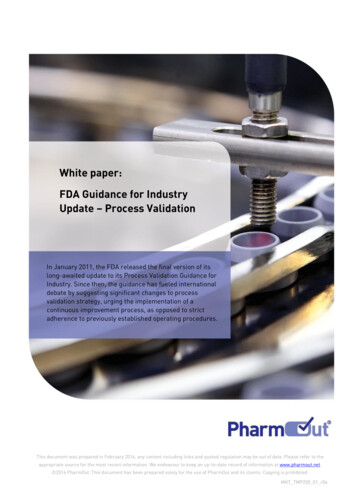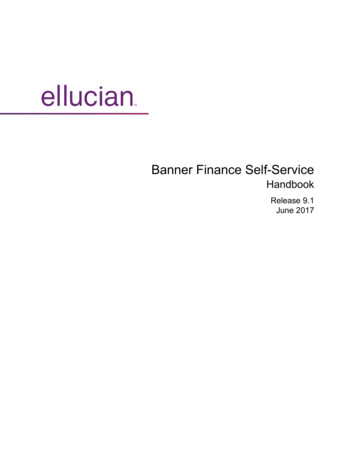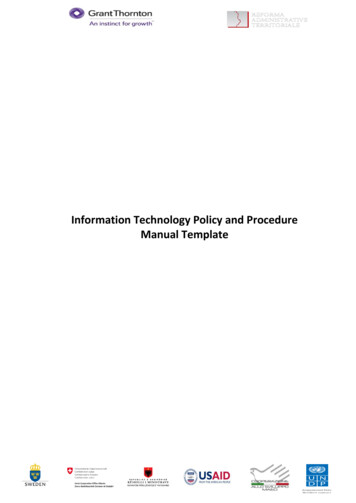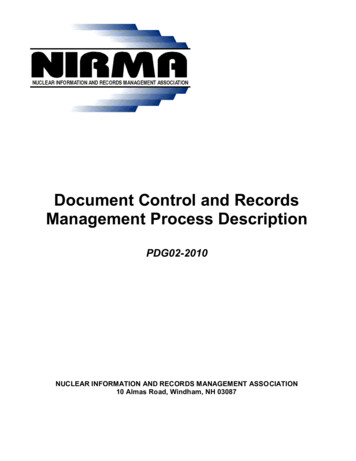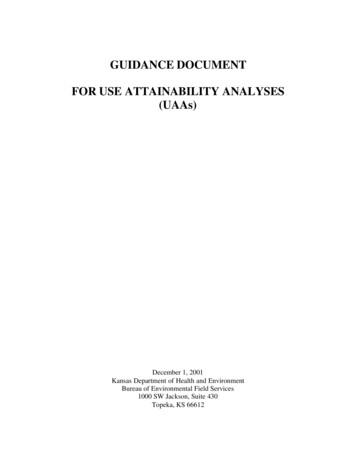
Transcription
GUIDANCE DOCUMENTFOR USE ATTAINABILITY ANALYSES(UAAs)December 1, 2001Kansas Department of Health and EnvironmentBureau of Environmental Field Services1000 SW Jackson, Suite 430Topeka, KS 66612
Table of ContentsIntroduction.1Aquatic Life Use UAA Protocol.5Primary and Secondary Recreational Use UAA Protocol.15Expedited Stream Recreational Use UAA Protocol.22Food Procurement Use UAA Protocol.29Water Supply Uses UAA Protocol.35Appendix A.43
1USE ATTAINABILITY ANALYSIS (UAA) PROTOCOLSI.IntroductionThe Kansas surface water quality standards (K.A.R. 28-16-28b through 28-16-28f) establishwater quality goals for all streams, lakes and wetlands occurring within the state or forming aportion of the border with an adjoining state. General narrative provisions in the standardsextend a basic level of protection to all such waters, irrespective of size or ownership.“Classified” waterbodies comprise an important subset of the waters of the state, in that they areassigned specific beneficial uses under the standards and are subject to numeric water qualitycriteria and related regulatory provisions. The level of protection afforded by the standards mayvary among classified waterbodies depending on their assigned uses and associated water qualitycriteria.The beneficial uses of approximately 2,500 stream segments, lakes and wetlands are delineatedin the Kansas Surface Water Register. This register also assigns unique identification numbersand geographical (latitude/longitude) descriptors to individual waterbodies based on U.S. EPAriver reach files.The protocols to develop use designations for surface waters in Kansas endeavors to providescientifically defensible information on the existing and attainable uses of classified streams,lakes and wetlands. This information is intended for use in:(1) complying with federal and state requirements for designating the beneficial uses ofsurface water (40CFR 131.10; K.A.R.28-16-28d);(2) responding to changes in the capacity of surface waters to support the beneficial usesrecognized under the Kansas standards;(3) identifying and applying appropriate water quality criteria and related regulatoryprovisions in the development of National Pollutant Discharge Elimination System(NPDES) permit limits, and total maximum daily loads (wasteload allocations & loadallocations);(4) responding to possible future changes in the wording of the Kansas standards withrespect to the beneficial uses of surface water; and(5) responding to requests by permitted facilities and other interested stakeholders toreview designated uses of surface waters.Separate protocols have been developed for determining aquatic life support uses,primary/secondary contact recreation use (including food procurement), and water supply uses.These protocols have been developed for use by external clients of the Kansas Department ofHealth and Environment for the development and submission of UAAs to the KDHE for review.II.Implementation Procedures*UAAs should be submitted to the Director, Bureau of Environmental Field Services,
2Kansas Department of Health and Environment, 1000 SW Jackson, Suite 430, Topeka, Kansas66612 for review. An internal KDHE review committee will meet quarterly, or more frequentlyif needed, to review all UAAs for accuracy, completeness and adequacy of statement offindings. If the UAA meets the stated criteria, it will be forwarded to the Data ManagementSection as a proposed change to the Kansas Surface Water Register. A written response to theentity submitting the UAA will be prepared by the Bureau of Environmental Field Services.The Surface Water Quality Commission recommended that the Basin AdvisoryCommittees assist the KDHE in examining the designated uses of streams within their basins.The basin advisory committees were established in 1985 for the twelve major river basins toadvise the Kansas Water Office and Kansas Water Authority on local water issues. As UAAs arecompleted and changes proposed, the proposed changes will be forwarded to the appropriateBasin Advisory Committee for discussion and review at their stated meetings.The Kansas Surface Water Register is adopted by reference in K.A.R. 28-16-28d(c)(2).K.A.R. 28-16-28d will be updated annually by the Bureau of Environmental Field Services toamend the register to reflect the findings of UAAs. A flow chart depicting the internal KDHEprocess for development of regulations is attached. The policies and procedures for filingKansas Administrative Regulations, as developed by the Department of Administration toimplement K.S.A. 77-415 through 77-437, will be followed (flow chart attached). Theseprocedures include public notice and a public hearing on proposed regulatory changes. Allentities who have submitted a UAA will be notified directly of the public hearing related toadoption of the revised register. UAAs and subsequent revisions to the Kansas surface waterquality standards are subject to approval by the Regional Administrator, U.S. EPA(40CFR131.20(c)* Flow chart attached.
3
4
5PROTOCOL FOR CONDUCTINGUSE ATTAINABILITY ANALYSIS (UAA)FORAQUATIC LIFE USE
6USE ATTAINABILITY ANALYSIS (UAA)FORAQUATIC LIFE USEWaterbody NameDateStream Chemistry Network Station (if applicable)BasinHUCSegmentDEFINITIONSAquatic life support use means the use of surface waters for the maintenance of the ecologicalintegrity of streams, lakes and wetlands. This includes the sustained growth and propagation ofnative aquatic life; naturalized, important, recreational aquatic life; and indigenous or migratorysemiaquatic or terrestrial wildlife directly or indirectly dependent on surface water for survival.In Kansas, the aquatic life support use is further designated as one of three subcategories: specialaquatic life use, expected aquatic life use, and restricted aquatic life use.1.2.3.Special aquatic life use (SALU) is assigned to surface waters which have the potential tocontain combinations of habitat types and indigenous aquatic life not commonly found inthe state, as well as waters containing or potentially containing populations of threatenedor endangered (T & E) species.Expected aquatic life use (EALU) is assigned to surface waters containing habitat types andindigenous aquatic life commonly found in Kansas. Essentially, this use is the “default”designation.Restricted aquatic life use (RALU) is assigned to surface waters where indigenous aquaticlife is limited in abundance or diversity due to natural deficiencies in, or artificialmodifications to, the physical quality of the habitatPREPARATION FOR UAAReview all applicable files, databases and maps in order to become thoroughly familiar with thewaterbody to be inspected and to determine what sampling should be accomplished. Indicatewhich resources have been reviewed and/or condition satisfied.X resource checked or condition satisfiedO resource not available or condition not satisfiedThe following materials are available from Kansas Department of Wildlife and Parks (KDWP):fishery resource maps and designationsstream survey maps and collection informationcritical habitat maps for T&E species
7fish collection records from KDWP stream surveysPublished and unpublished stream fish collection data are also available from:Kansas Department of Health and Environment (KDHE)Fort Hays State UniversityUniversity of Kansas Museum of Natural HistoryKansas Biological Survey, Natural Heritage ProgramUnionid mussel collection records and other macroinvertebrate records are available from:Kansas Biological Survey, Natural Heritage ProgramKDHE (KDHE Mussel Database)Fort Hays State UniversityWichita State UniversityRecords of collection, observation and reproduction of other aquatic and semi-aquatic wildlife,including reptiles, amphibians and birds, are available from:Emporia State UniversityKansas State UniversityKansas Ornithological SocietyKansas Herpetological SocietyKansas Biological Survey, Natural Heritage ProgramDOCUMENTATION OF LITERATURE SEARCHIdentify all known aquatic and semiaquatic species associated with the waterbody and cite theliterature or database source.USE ASSESSMENT PROCEDURESAquatic life support use shall be considered to be existing in all currently classified waterbodies inKansas and attainable if the waterbody meets the criteria for classification set forth in L2001,ch.100, sec.1, which describes classified streams as follows:1.Classified streams shall include:A. All streams with a 10-year median flow of equal to or in excess of 1cubic foot per second (1.0 cfs). Regardless of flow, a stream shall be classified ifstudies conducted or accepted by the department show that pooling of water duringperiods of zero flow provides important refuges for aquatic life and permitsbiological recolonization of intermittently flowing segments and a cost/benefitanalysis indicates that the benefits of classifying the stream outweigh the costs ofclassifying the stream.B. All streams actually inhabited by threatened or endangered aquaticspecies listed in rules and regulations promulgated by the Kansas Department ofWildlife and Parks or the U.S. Fish and Wildlife Services.C. All streams which are at the point of discharge and downstream fromsuch point where the Department has issued a National Pollutant Discharge
8Elimination System Permit other than a permit for a confined feeding facility.2.Classified lakes shall be all lakes owned by federal, state, county or municipalauthorities and all privately owned lakes that serve as public drinking water suppliesor that are open to the general public for primary or secondary contact recreation.(K.A.R. 28-16-28d)3.Classified wetlands shall be all wetlands owned by federal, state, county, ormunicipal authorities, all privately owned wetlands open to the general public forhunting, trapping or other forms of secondary contact recreation, and all wetlandsclassified as outstanding national resource waters, exceptional state waters, ordesignated as special aquatic life use waters.”. (K.A.R. 28-16-28d)Special aquatic life use (SALU) - This use shall be considered existing if the waterbody segmentis:designated as critical habitat for T&E species, oris found to contain T&E species or species in need of conservation (SINC) during fieldcollection activities.The special aquatic life use shall be considered attainable if:the waterbody falls within the geographic range of T&E or SINC species, andpossesses hydrologic and habitat components consistent with the known requirements ofthese species.Restricted aquatic life use (RALU) - This use shall be assigned to surface waters if:indigenous aquatic life is limited in abundance or diversity by the physical quality of thehabitat due to natural deficiencies or artificial modifications.Examples of such natural deficiencies or modifications are:concrete lined diversion canals,subterranean aqueducts, andchannels so extensively modified that no natural or artificially provided habitat ispresent.Expected aquatic life use (EALU) - This is the default designation for aquatic life support. It isassigned whenthe waterbody is classified, andnot designated as SALU or RALU.The Expected aquatic life use shall be considered attainable when:the waterbody meets the State’s criteria for classification,The Expected aquatic life use shall be considered existing when:the waterbody is classified and aquatic life is known to be present.Cost effective best management practices for non-point sources are found in Appendix A.
9FIELD ASSESSMENT PROCEDURES FOR AQUATIC LIFE USE DESIGNATIONSIf there is insufficient information concerning resident aquatic communities, it will be necessary todocument the aquatic life community through field assessments. Field assessments must beconducted by a qualified aquatic biologist. A qualified aquatic biologist includes any person withappropriate post-secondary coursework in aquatic biology, aquatic ecology, aquatic invertebratezoology, ichthyology, and/or limnology combined with field experience in the identification ofaquatic and semiaquatic species native to Kansas.1.Field activities begin with a visual inspection of the targeted waterbody at severalrandomly selected locations. Those locations deemed most representative of thewaterbody are selected for further study. If a site is believed to afford unusual oroutstanding biological habitat, it is included as an additional study location even if itis unrepresentative of the waterbody as a whole. This increases the likelihood thatrare or unusual biological assemblages will be identified and assigned anappropriate level of protection under the water quality standards. For a lake orwetland, one site may be adequate to characterize existing or potential uses. Streamor river UAAs will generally have more sites (a minimum of three) due to thepossibility of anomalous habitat conditions at any given access point. Stream sites(reaches) selected for study should extend in length at least ten times the width ofthe stream as measured from the high water mark, i.e., top of the stream banks.2.Assessment sites shall be designated for each UAA and clearly marked on 1:24,000scale (7.5 minute series) United States Geological Survey (USGS) topographicmaps (available at: www.topozone.com). If possible, global positioning system(GPS) coordinates should be taken on-site and recorded on field forms.3.If access to the waterbody is to be made on private property, landowner or residentpermission should be secured prior to access (K.S.A. 21-3721).4.Narrative UAA site assessments are to be clearly recorded, either by electronic orwritten means, at each assessment site. To eliminate risk of mistakes or confusionregarding uses among multiple sites, record observations before moving to thenext assessment site.The written assessment must specify the targeted waterbody, its legal location, GPScoordinates (if available), field physical and chemical data, photographic exposureinformation, stream width, depth and flow estimations, habitat types present,existing uses actually observed, observations of unusual conditions such as algalblooms, dead fish or unusual odors, streambank water diversions or alluvial wells(located within 50 feet of the waterbody), observations of aquatic life such as fish ormussels, and observations of semiaquatic life such as amphibians, waterfowl, orfurbearers. Complete forms APP. D-1 through D-5, as appropriate to the type ofwaterbody.5.At a minimum, dissolved oxygen, pH, specific conductance, and temperature mustbe measured at each assessment site and documented on the appropriate stream,lake or wetland physical characterization data sheet. Sample collection and analysis
10must follow the standard methods described in Standard Methods for theExamination of Water and Wastewater, 17th Ed., 1989 (or later edition), WashingtonDC: American Public Health Association.6.A photographic record must be made of sites assessed for the UAA. Photographsmust include an upstream view, downstream view, and any photographs required todocument observed or potential uses. Photographs must be marked or catalogued ina manner which indicates the site location and sampling date and what is beingshown by each photograph.7.If possible, streamside or other local landowners or residents should be interviewedregarding present or past uses of the waterbody and any social benefits of thewaterbody. Persons interviewed should be identified by name and legal address inthe written assessment.8.Biological community sampling will normally focus on two groups of organisms,fish and molluscs. Numerous fish and mollusc species are listed as T&E or SINCspecies and often form the basis for designating a waterbody segment either SALUor EALU. Juvenile forms of aquatic insects may also be collected to assist indesignation of the waterbody segment. Forms APP D-6 and C-3 relate to thecollection, preservation and identification of aquatic and semiaquatic species.Complete as appropriate.9.Prior to any fish or mollusc collection activities, a scientific collector’s permit mustbe obtained from Kansas Department of Wildlife & Parks (phone 316-672-5911)and, if federally protected species are likely to be encountered, United States Fish& Wildlife Service (USFWS) (phone 303-236-7920).10.Fish collection procedures must focus on a multi-habitat approach, allowing thesampling of habitats in relative proportion to their local availability. Each samplereach should contain riffle, run and pool habitats, if present. If possible, the samplereach should be located away from the influences of point and localized nonpointsources of pollution and channelized bridge or road crossings. Ability to access andwade the waterbody may ultimately govern the exact placement of the sample reach.Each type of available habitat (riffle, run, pool, undercut banks, aquatic vegetation,etc.) must be sampled extensively until no new species are found in repeated seinehauls. This means at least three consecutive seine hauls with no new species, evenunder optimal seining conditions. Sub-optimal seining conditions may require moreextensive sampling activities, guided by the professional judgement of the aquaticbiologist conducting the sampling. The use of electrofishing equipment is analternate method for sampling and enumerating fish communities. Habitatassessment worksheets, appropriate for the type of waterbody, (Forms APP. D-1through D-5) must be completed to document habitats present and sampled.11.Fish (except young-of-the-year) collected within the sample reach must be identified
11to species (or subspecies) and enumerated. Field identifications are acceptable;however voucher specimens should be retained for laboratory verification,particularly if there is any doubt about the correct identity of the specimen.Specimens that cannot be identified with certainty in the field must be preserved ina 10 percent formalin solution and stored in labeled containers for subsequentlaboratory identification. A representative voucher collection must be retained forunidentified specimens, very small specimens, and new locality records.In addition to the unidentified specimen jar, a voucher collection of a sub-sample ofeach species identified in the field must be preserved and labeled for subsequentlaboratory verification (with the exception of large, readily identifiable species - i.e.,carp, flathead catfish, etc., for which photographic documentation may suffice).At a minimum labels must display location data (verbal description and legalcoordinates), collection date, collectors’ names, and sample identification code orstation number for the particular sampling site.Voucher specimens and collections must be made available to KDHE forverification and/or cataloguing in the collection of the University of KansasMuseum of Natural History, Division of Fishes.Immediately following the data recording phase of the procedure, specimens thathave been identified and enumerated in the field should be released on-site tominimize mortality.12.Identification of fish must be conducted by a qualified aquatic biologist familiarwith taxonomy of local and regional ichthyofauna. The accurate identification ofeach fish collected is essential and species-level identification is required.Questionable records are prevented by: a) requiring the presence of at least onequalified aquatic biologist with experience in fish taxonomy on every samplingeffort, and b) preserving selected specimens which cannot be readily identified inthe field for laboratory verification. It is recommended that a maximum sub-samplesize of 25 specimens of each species be collected. Only one or two specimens needto be collected of T&E and SINC species. Taxonomic nomenclature must be keptconsistent and current. Common and scientific names of fishes are listed inCommon and Scientific Names of Fishes from the United States and Canada, 5thedition, American Fisheries Society, Special Publication 20. Bethesda, Maryland,1991.13.Unionid mussels present at the sample points must be identified and recorded. Liveunionid mussels should be recorded, photographed, and immediately released onsite (with the possible exception of voucher specimens). Photographicdocumentation is especially important for T&E and SINC species, which shouldgenerally be released on-site. Remnant valves (recent, weathered and semi-fossil)must be collected in numbers proportional to their presence and made available toKDHE for identification, cataloguing and archiving.
1214.Unionid mussels encountered within the sample reach must be identified to species(or subspecies) and enumerated. Voucher specimens must be retained forlaboratory verification if there is any doubt about the correct identity of thespecimen. Live specimens that cannot be identified with certainty in the fieldshould be preserved individually in a 10 percent formalin solution and stored inlabeled containers for subsequent laboratory identification. A representativevoucher collection must be retained for unidentified and very small live specimensin the absence of recently deceased specimens or unweathered shell materials.Voucher specimens must be clearly labeled for subsequent laboratory verification.At a minimum labels must display location data (verbal description and legalcoordinates), collection date, collectors’ names, and sample identification code orstation number for the particular sampling site.Preserved voucher specimens and collected shell materials must be madeavailable to KDHE for verification and/or cataloguing in the KDHE musselcollection or other appropriate repository (e.g., University of Kansas Museumof Natural History).Immediately following the data recording phase of the procedure, any livespecimens that have been identified and enumerated in the field should be carefullyreleased on-site to minimize mortality.15.Identification of unionid mussels must be conducted by a qualified aquatic biologistfamiliar with the taxonomy of local and regional unionid mussel fauna. Theaccurate identification of each unionid mussel collected is essential and specieslevel identification is required. Questionable records are prevented by: a) requiringthe presence of at least one qualified aquatic biologist familiar with taxonomy ofunionid mussels on every field effort, and b) preserving selected specimens (liveindividuals or unweathered valves) of each species and those which cannot bereadily identified in the field for laboratory verification. Taxonomic nomenclaturemust be kept consistent and current. Common and scientific names of unionidmussels are listed in Common and Scientific Names of Aquatic Invertebrates fromthe United States and Canada: Mollusks, 2nd edition, American Fisheries Society,Special Publication 26, Bethesda, Maryland, 1998.FINDINGS OF AQUATIC LIFE USE UAAA written statement of finding and all supporting documentation must be presented to KDHE forreview. The statement must include pertinent findings that support the designation being proposedfor adoption in the Kansas Surface Water Quality Standards, K.A.R. 28-16-28d. If field andtaxonomic assessments have been conducted a statement of the qualifications of the participatingbiologists must be included.
13Form E-1FIELD ASSESSMENT WORKSHEETUSE ATTAINABILITY ANALYSIS (UAA)FORAQUATIC LIFE USEHUC:Segment:Waterbody Name:Basin:Location (Legal):1/41/4 Sec.Evaluators:Site Location Map or attach photographs:Township.RangeQuadrangleDate:Economic Considerations:What activities are apparent along the stream that might impact the water quality of the streamsegment, i.e. discharges, crop land, grazing activities, etc.?
14FORMSAPP. C-3 andAPP. D-1 through D-6
Form App. C-3
Form App. D-1
Form App. D-2
Form App. D-3
Form App. D-4
Form App. D-5
15Form App. D-6FISH COLLECTIONS:StationDateCollectorsWater TemperatureSeines Used: ft.Areaft.AreaFish collection preserved?Identified by:Electrofishing? Yes NoComments:Species account:SpeciesNumber KeptNumber Released
16PROTOCOL FOR CONDUCTINGUSE ATTAINABILITY ANALYSIS (UAA)FORPRIMARY AND SECONDARY CONTACT RECREATION
17USE ATTAINABILITY ANALYSIS (UAA)FORPRIMARY AND SECONDARY CONTACT RECREATIONPREPARATION FOR UAAReview all applicable files, databases and maps in order to become thoroughly familiar with thewaterbody to be inspected and to determine what assessment should be accomplished.The following materials are available from the Kansas Department of Wildlife and Parks (KDWP)and may obviate the need for onsite survey:fishery resource maps and designationsstream survey maps and collection informationfish collection records from KDWP stream surveysUSE ASSESSMENT PROCEDURESClassified waters shall be evaluated for recreational uses using the procedures set forth in thissection and the criteria for classification set forth in L2001, ch. 100, sec. 1, which describesclassified streams as follows:1.Classified streams shall include:A. All streams with a 10-year median flow of equal to or in excess of 1cubic foot per second (1.0 cfs). Regardless of flow, a stream shall be classified ifstudies conducted or accepted by the department show that pooling of water duringperiods of zero flow provides important refuges for aquatic life and permitsbiological recolonization of intermittently flowing segments and a cost/benefitanalysis indicates that the benefits of classifying the stream outweigh the costs ofclassifying the stream.B. All streams actually inhabited by threatened or endangered aquaticspecies listed in rules and regulations promulgated by the Kansas Department ofWildlife and Parks or the U.S. Fish and Wildlife Services.C. All streams which are at the point of discharge and downstream fromsuch point where the Department has issued a National Pollutant DischargeElimination System Permit other than a permit for a confined feeding facility.2.Classified lakes shall be all lakes owned by federal, state, county or municipalauthorities and all privately owned lakes that serve as public drinking water suppliesor that are open to the general public for primary or secondary contact recreation.(K.A.R. 28-16-28d)3.Classified wetlands shall be all wetlands owned by federal, state, county, ormunicipal authorities, all privately owned wetlands open to the general public forhunting, trapping or other forms of secondary contact recreation, and all wetlandsclassified as outstanding national resource waters, exceptional state waters, ordesignated as special aquatic life waters.”.(K.A.R. 28-16-28d)
18Primary contact recreation shall be considered an existing use in all classified waterbodies knownto host one or more of the following activities:swimmingskin divingboatingwaterskiingmussel harvestingwindsurfingor which hosted one or more of these activities on or after November 28, 1975 (based oninterviews with streamside landowners or other knowledgeable individuals or other dateddocumentation).In order to protect public health, the primary contact recreation use shall be assigned as anattainable use to all waters along: (check applicable conditions)public parkspublic parkwaysurban streamsand other waters with a high probability of public access: (check applicable conditions)boat rampsnature trailsplaygroundscamping areasSecondary contact recreation - At a minimum, all classified surface waters shall be designated forthis use. It shall be considered an existing use in those waterbodies exhibiting indications of oneor more of the following activities:wadingtrappingfishinghuntingor which exhibited one or more of these activities on or after November 28, 1975 (based oninterviews with streamside landowners or other knowledgeable individuals or other dateddocumentation).The secondary contact recreation use shall be considered attainable if:the waterbody meets the criteria for classification set forth in K.A.R. 28-16-28d(b).Cost effective best management practices for non-point sources are found in Appendix A.FIELD ASSESSMENT FOR PRIMARY & SECONDARY CONTACT RECREATION ANDFOOD PROCUREMENT1.Field activities should begin with a visual inspection of the targeted waterbody atseveral locations. Those stream sites deemed most likely to support primary contactrecreation and/or food procurement should be selected for further study. For a lakeor wetland, one site may be adequate to characterize existing or potential uses. Thenumber of sites to be assessed on a given waterbody should be determined prior tocommencement of field activities. Form E-1 should be used to record findings.2.Assessment sites should be designated for each UAA and clearly marked on1:24,000 scale (7.5 minute series) USGS topographic maps (available at:www.topozone.com). If possible, global positioning system (GPS) coordinates
19should be taken on-site and recorded on field forms.3.If access to the waterbody is to be made through private property, landowner orresident permission should be secured prior to access (K.S.A. 21-3721).4.Narrative UAA site assessments must be clearly recorded, either by electronic orwritten means, at each assessment site. To reduce the risk of mistakes or confusionregarding existing or attainable uses among multiple sites, it is necessary to recordobservations before moving to the next assessment site.The recorded field assessment must specify the waterbody assessed, legal location,GPS coordinates (if available), field physical data, photographic exposureinformation, stream width, depth and flow estimations, existing uses actuallyobserved, and any oth
_ Kansas Department of Health and Environment (KDHE) _ Fort Hays State University _ University of Kansas Museum of Natural History _ Kansas Biological Survey, Natural Heritage Program Unionid mussel collection records and other macroinvertebrate records are available from: _ Kansas Bio




